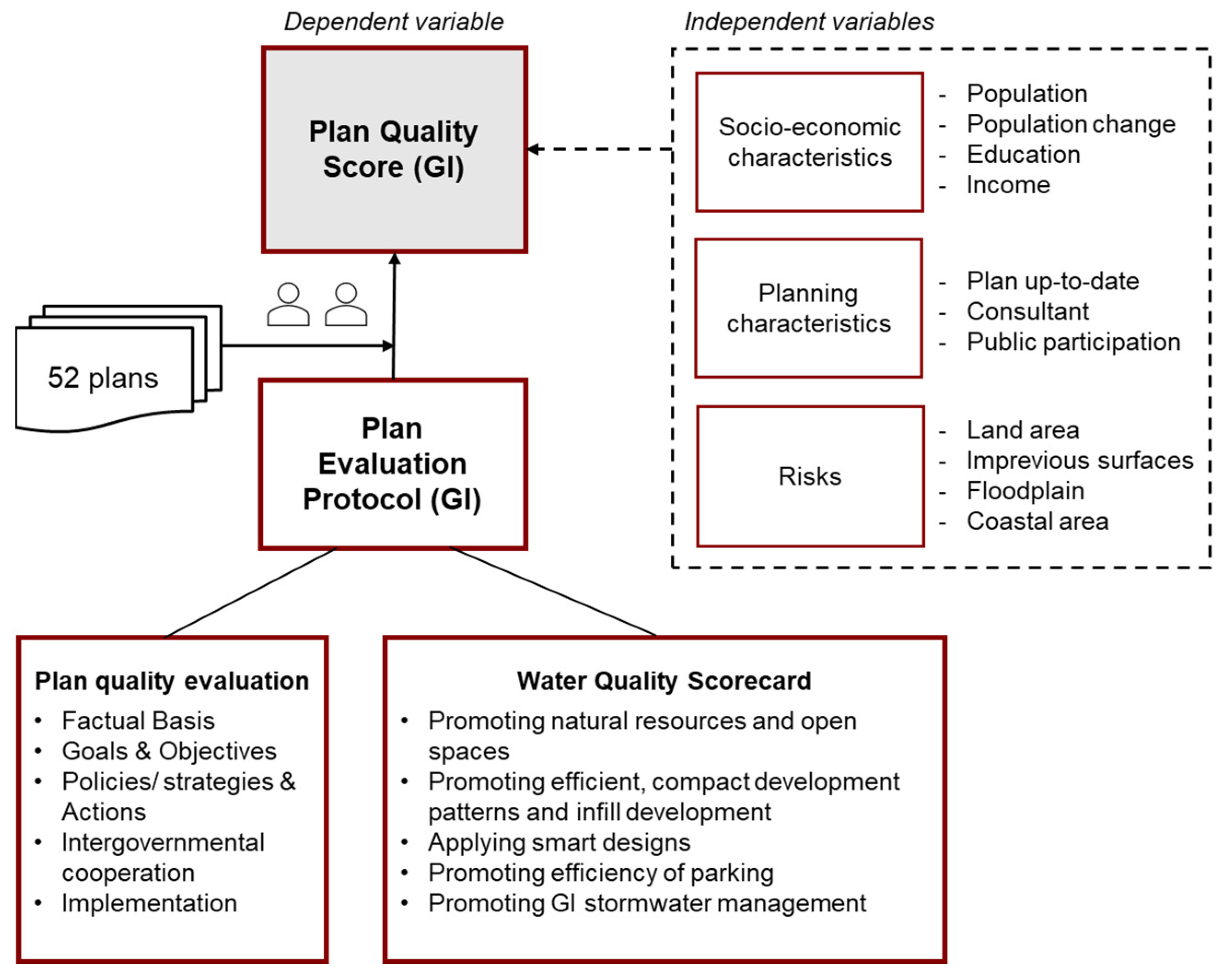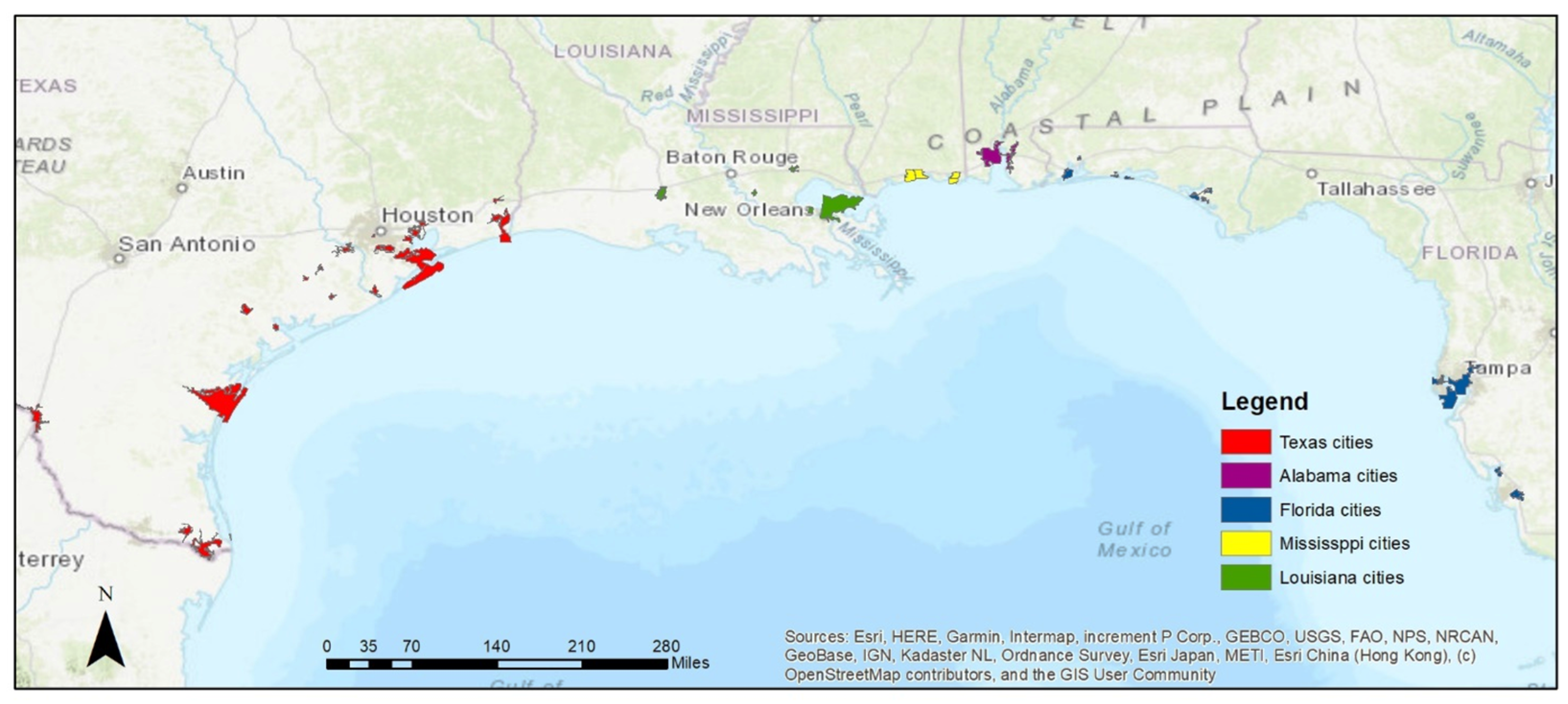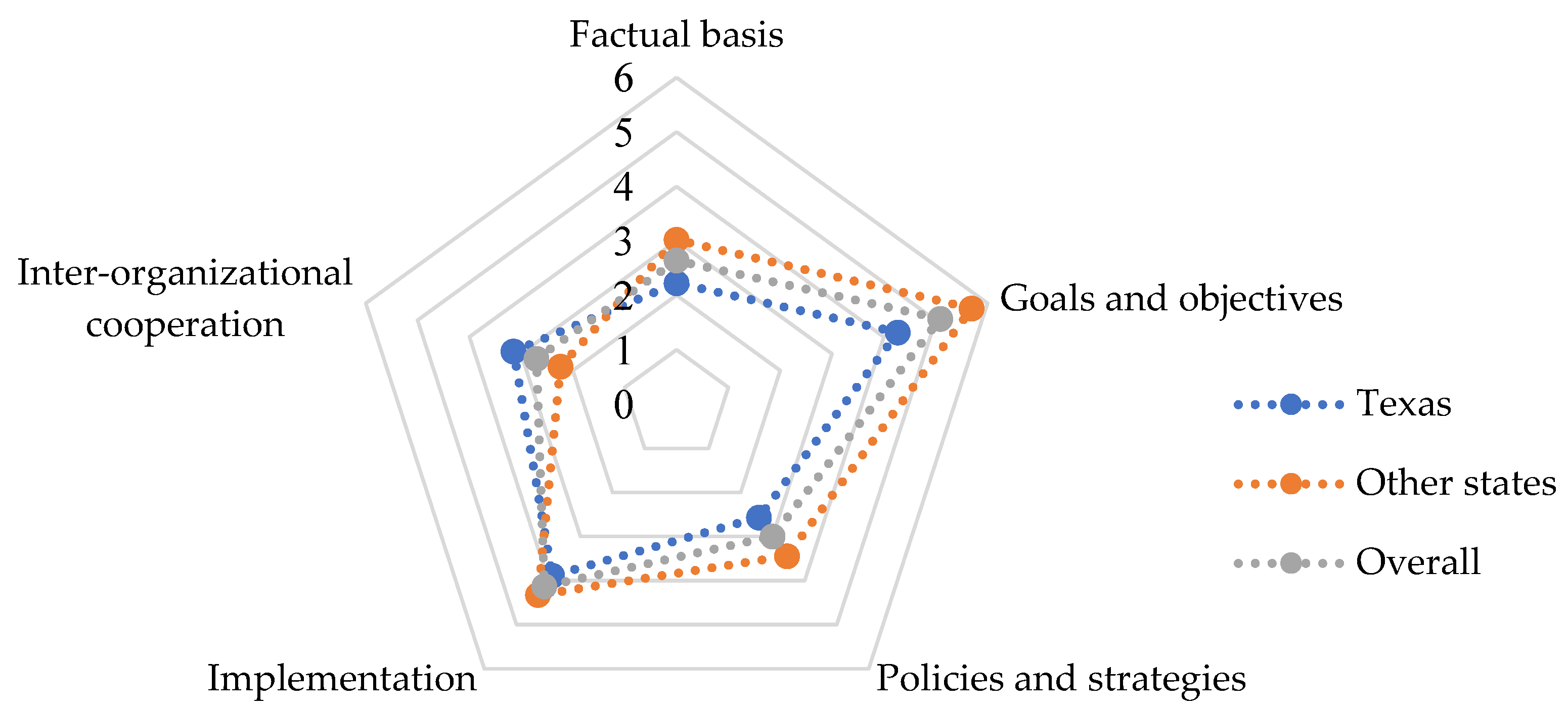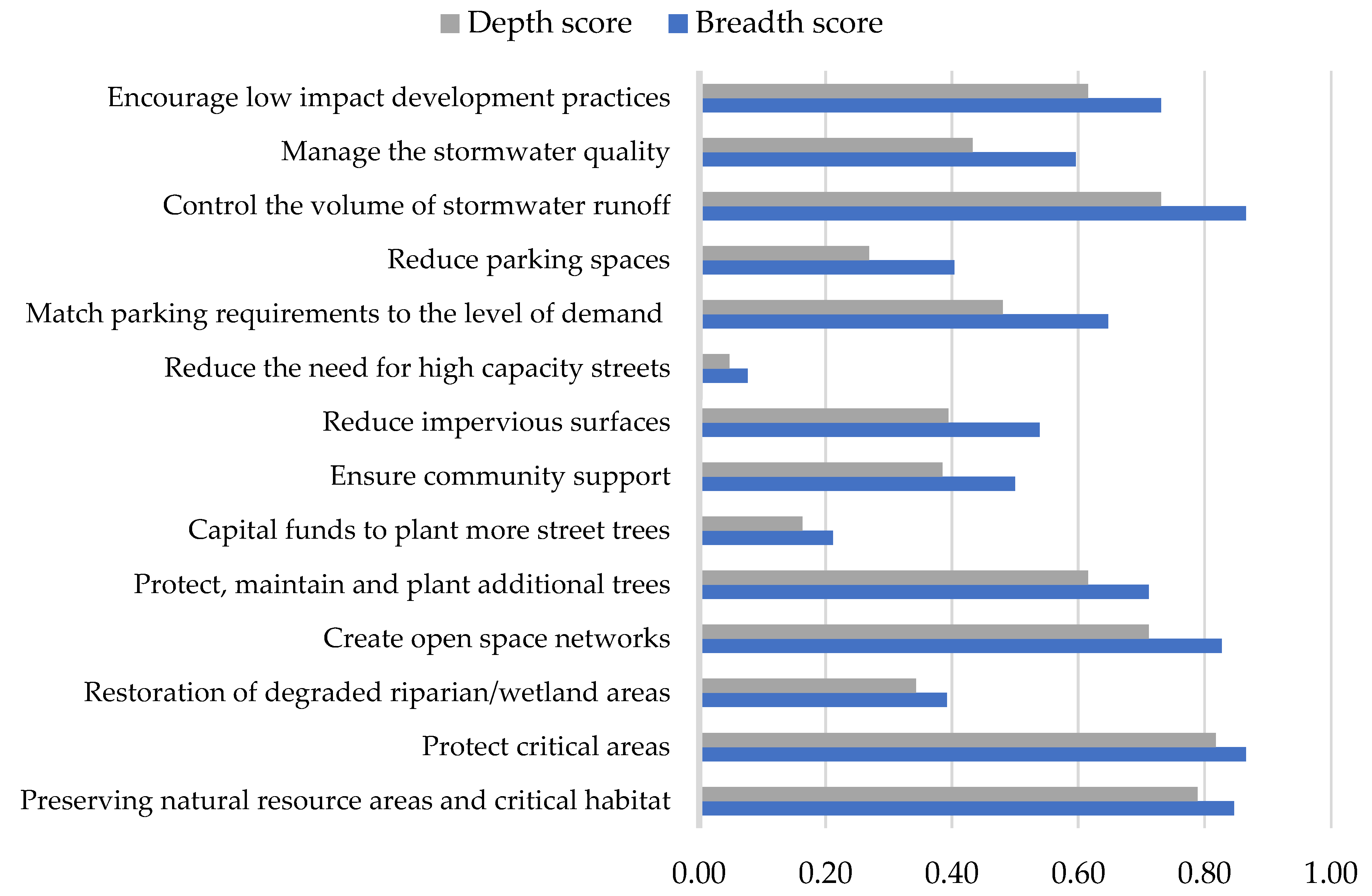An Evaluation of Local Comprehensive Plans Regarding Green Infrastructure in 52 Cities across the U.S. Gulf Coast Region
Abstract
1. Introduction
2. Materials
2.1. Green Infrastructure and Green Infrastructure Approaches
2.2. Plan Quality Evaluation
- Promoting natural resources and open spaces: this principle assesses how the local government concerns about natural resources and open spaces, and how it acts to protect these resources from future development;
- Promoting efficient, compact development patterns and infill development: this principle seeks to evaluate how the local government encourages sustainable development for urban areas, including infill, redevelopment for brownfields and grey-fields, mixed-use, and transit-oriented development;
- Applying smart design strategies: this principle focuses on evaluating the design aspect of urban development, in particular the reduction in impervious surfaces. These strategies might include the integration between street design and green infrastructure, paving materials for the sidewalk, public streets, driveways, parking lots, and other traffic infrastructures;
- Promoting the efficiency of parking: this principle assesses the effectiveness of parking. It examines how well the local government manages transportation demands, reduces parking requirements, and minimizes stormwater runoff from parking lots; and
- Promoting GI stormwater management: the final principle addresses the performance of the local government in governing GI practices. It addresses how GI practices are integrated into stormwater management provisions of the city, how the local government maintains and enforces green infrastructure, and how the public is encouraged (through education and outreach) to use GI practices effectively.
2.3. Factors Influencing Plan Quality Regarding Green Infrastructure
2.3.1. Socio-Economic Characteristics
2.3.2. Planning Characteristics
2.3.3. Risks
3. Methods
3.1. Sample Selection
3.2. Data Entry
- Plan quality score was obtained through content analysis of GI principles of city comprehensive plans. To ensure transparency and minimize bias during the assessment and the coding process, Lacy et al. [38] recommended that two or more trained coders should independently code content units. Additionally, it is important for at least one of the coders to not have been involved in developing the protocol. Accordingly, 52 comprehensive plans were evaluated by the two researchers working independently of each other from Fall 2019 to Spring 2020. Intercoder reliability scores of each component from the two coders were then computed. Reliability score was measured the number of agreements in coding divided by the number of total items in each component (simple agreement). A score of 80% and above was considered acceptable according to previous studies [39,40]. In this study, an overall intercoder reliability score of approximately 82% was achieved. In cases of disagreement, they were resolved referring to the qualitative content of the plan through discussions. Additionally, as suggested by Lacy, Watson, Riffe, and Lovejoy [38], Krippendorff’s alpha was conducted in order to determine the consistency of inter-item. The overall alpha value for all plan components was approximately 0.78, which was close to the cutoff threshold of 0.8 indicating good reliability.
- Census data for each city were used to identify the local population size (2010), the change in population from 2010 to 2020, the level of education attainment (2010), and median household income (2010). These types of data were all collected from the 2010 and 2020 Census data which are also the most two recent U.S. censuses (U.S. Census Bureau).
- GIS data (including the percentage of the 100-year floodplain, percentage of impervious surface, and coastal area) were obtained using ArcMap 10.8. This information was used to represent the risks posed by coastal cities in the Gulf Coast region. The percentage of 100-year floodplain in the city was calculated based on the National Flood Hazard Layer (NFHL) 2019, collected from the FEMA Flood Map Service Center. However, many cities lack GIS floodplain information. Alternatively, floodplain maps in other types of data (e.g., jpeg, pdf) were collected and the percentage of the floodplain was calculated using Adobe Photoshop. This involved dividing the total number of pixels within the 100-year floodplain by the total number of pixels covering the entire city boundary. Impervious surface data were calculated using the National Land Cover Database (NLCD) 2016 Percent Developed Imperviousness (CONUS) collected from the U.S. Geological Survey (USGS). Coastal area is a dummy variable with a score of 1 indicating that the city is located adjacent to the coastal line with a higher risk of flooding (see Table 1).
- Planning data, including plan adopted year, consultant, and the number of public participation techniques were collected from each city’s comprehensive plan or city official website. Where data were not available, information was collected by personally contacting the city’s planning staff.
3.3. Evaluation Criteria
3.4. Data Analysis
4. Results
4.1. Descriptive Analysis
4.2. Analysis by Plan Components
4.3. Regression Analysis
5. Discussions and Conclusions
Author Contributions
Funding
Institutional Review Board Statement
Informed Consent Statement
Data Availability Statement
Acknowledgments
Conflicts of Interest
Appendix A
| City | State | I | II | III | IV | V | Total |
|---|---|---|---|---|---|---|---|
| Aransas Pass | TX | 2.08 | 4.71 | 1.50 | 5.63 | 3.50 | 17.41 |
| Bay City | TX | 0.56 | 2.35 | 0.88 | 1.88 | 1.50 | 7.16 |
| Baytown | TX | 2.92 | 4.71 | 3.38 | 0.00 | 3.50 | 14.50 |
| Bellaire | TX | 1.53 | 3.53 | 2.38 | 5.63 | 4.00 | 17.06 |
| Biloxi | MS | 2.92 | 6.47 | 3.63 | 3.75 | 1.00 | 17.76 |
| Brownsville | TX | 4.03 | 5.00 | 3.88 | 5.63 | 4.00 | 22.53 |
| Callaway | FL | 0.42 | 4.12 | 2.50 | 2.50 | 0.00 | 9.53 |
| Clearwater | FL | 3.75 | 7.65 | 5.25 | 5.63 | 0.50 | 22.77 |
| Corpus Christi | TX | 1.25 | 5.59 | 3.50 | 2.50 | 2.00 | 14.84 |
| Daphne | AL | 2.36 | 3.24 | 0.63 | 3.75 | 2.00 | 11.97 |
| Destin | FL | 3.75 | 6.18 | 4.50 | 6.88 | 2.00 | 23.30 |
| Dickinson | TX | 1.25 | 2.35 | 0.63 | 0.63 | 3.00 | 7.85 |
| El Campo | TX | 2.22 | 4.12 | 1.75 | 4.38 | 2.00 | 14.46 |
| Fairhope | AL | 0.97 | 5.29 | 2.75 | 2.50 | 3.00 | 14.52 |
| Fort Myers | FL | 2.36 | 3.53 | 1.25 | 1.88 | 5.00 | 14.02 |
| Fort Walton Beach | FL | 1.94 | 5.29 | 3.13 | 3.75 | 1.00 | 15.11 |
| Galveston | TX | 3.06 | 6.76 | 4.25 | 5.63 | 3.50 | 23.20 |
| Gonzales | LA | 1.11 | 5.29 | 3.00 | 2.50 | 2.50 | 14.41 |
| Gretna | LA | 4.58 | 5.59 | 2.88 | 6.88 | 3.00 | 22.92 |
| Gulfport | MS | 4.86 | 7.06 | 3.00 | 1.25 | 3.50 | 19.67 |
| Hammond | LA | 4.44 | 7.35 | 5.25 | 2.50 | 4.50 | 24.05 |
| Harlingen | TX | 2.78 | 3.82 | 2.38 | 3.13 | 2.00 | 14.10 |
| Ingleside city | TX | 1.11 | 2.94 | 1.38 | 5.00 | 2.50 | 12.93 |
| Kenner | LA | 2.50 | 4.12 | 0.88 | 3.13 | 4.50 | 15.12 |
| La Porte | TX | 1.94 | 5.88 | 3.50 | 5.63 | 2.50 | 19.45 |
| Lafayette | LA | 2.92 | 5.29 | 4.63 | 8.13 | 5.00 | 25.96 |
| Lake Jackson | TX | 1.94 | 4.12 | 2.00 | 6.25 | 2.50 | 16.81 |
| Laredo | TX | 2.92 | 6.76 | 5.63 | 2.50 | 6.00 | 23.81 |
| League City | TX | 5.00 | 8.24 | 4.50 | 2.50 | 4.00 | 24.24 |
| Milton | FL | 5.28 | 6.18 | 3.75 | 7.50 | 0.00 | 22.70 |
| Mobile | AL | 2.64 | 4.41 | 2.50 | 6.25 | 3.00 | 18.80 |
| Mont Belvieu | TX | 2.50 | 4.71 | 4.00 | 1.25 | 3.00 | 15.46 |
| Moss Point | MS | 2.50 | 3.53 | 1.38 | 1.88 | 1.50 | 10.78 |
| New Orleans | LA | 2.08 | 6.18 | 4.00 | 8.13 | 3.00 | 23.38 |
| Panama City | FL | 0.42 | 2.94 | 3.63 | 1.25 | 0.00 | 8.23 |
| Pascagoula | MS | 2.50 | 7.65 | 4.50 | 3.13 | 0.50 | 18.27 |
| Pearland | TX | 2.36 | 4.71 | 4.00 | 6.25 | 4.50 | 21.82 |
| Pensacola | FL | 1.81 | 7.06 | 5.13 | 6.25 | 1.00 | 28.30 |
| Port Arthur | TX | 3.06 | 5.00 | 2.88 | 6.25 | 5.00 | 22.18 |
| Port Lavaca | TX | 3.19 | 3.24 | 1.50 | 3.75 | 4.00 | 15.68 |
| Portland | TX | 2.08 | 3.82 | 1.63 | 1.88 | 3.50 | 12.91 |
| Punta Gorda | FL | 6.11 | 7.65 | 4.38 | 2.50 | 2.50 | 23.13 |
| Richmond | TX | 1.25 | 4.71 | 1.75 | 2.50 | 3.00 | 13.21 |
| Rosenberg | TX | 2.22 | 3.53 | 2.25 | 6.25 | 3.50 | 17.75 |
| South Padre Island | TX | 1.67 | 4.71 | 3.75 | 2.50 | 1.50 | 14.12 |
| Spanish Fort | AL | 3.33 | 4.41 | 2.25 | 4.38 | 2.50 | 16.87 |
| St. Petersburg | Fl | 5.56 | 7.65 | 5.88 | 6.25 | 2.50 | 27.83 |
| Tampa | FL | 4.44 | 8.24 | 5.50 | 5.63 | 2.00 | 25.80 |
| Texas City | TX | 0.42 | 1.76 | 0.13 | 2.50 | 1.50 | 6.31 |
| Victoria | TX | 1.94 | 2.65 | 2.75 | 6.88 | 2.00 | 16.22 |
| Vidor | TX | 1.94 | 0.59 | 0.25 | 1.25 | 3.50 | 7.53 |
| Wharton | TX | 2.92 | 5.00 | 3.00 | 6.88 | 3.50 | 21.29 |
References
- NOAA. What Threats Do Coastal Communities Face? Available online: https://oceanservice.noaa.gov/hazards/ (accessed on 25 January 2023).
- Schwab, J. Planning for Post-Disaster Recovery: Next Generation; American Planning Association: Chicago, IL, USA, 2014. [Google Scholar]
- McPhearson, T.; Andersson, E.; Elmqvist, T.; Frantzeskaki, N. Resilience of and through urban ecosystem services. Ecosyst. Serv. 2015, 12, 152–156. [Google Scholar] [CrossRef]
- Kaiser, E.J.; Godschalk, D.R. Twentieth century land use planning: A stalwart family tree. J. Am. Plan. Assoc. 1995, 61, 365–385. [Google Scholar] [CrossRef]
- Kim, H.; Tran, T. An Evaluation of Local Comprehensive Plans Toward Sustainable Green Infrastructure in US. Sustainability 2018, 10, 4143. [Google Scholar] [CrossRef]
- Benedict, M.A.; McMahon, E.T. Green Infrastructure: Smart Conservation for the 21st Century, Sprawl Watch Clearinghouse Monograph Series. Renew. Resour. J. 2002, 20, 12–17. [Google Scholar]
- Benedict, M.A.; McMahon, E.T. Green Infrastructure: Linking Landscapes and Communities; Island Press: Washington, DC, USA, 2012. [Google Scholar]
- USEPA. Water Quality Scorecard: Incorporating Green Infrastructure Practices at the Municipal, Neighborhood, and Site Scales; US EPA: Washington, DC, USA, 2009. [Google Scholar]
- Lennon, M. Green infrastructure and planning policy: A critical assessment. Local Environ. 2015, 20, 957–980. [Google Scholar] [CrossRef]
- Berke, P.; Godschalk, D. Searching for the good plan: A meta-analysis of plan quality studies. J. Plan. Lit. 2009, 23, 227–240. [Google Scholar] [CrossRef]
- Hill, M. A goals-achievement matrix for evaluating alternative plans. J. Am. Inst. Plan. 1968, 34, 19–29. [Google Scholar] [CrossRef]
- Baer, W.C. General plan evaluation criteria: An approach to making better plans. J. Am. Plan. Assoc. 1997, 63, 329–344. [Google Scholar] [CrossRef]
- Berke, P.R. Enhancing plan quality: Evaluating the role of state planning mandates for natural hazard mitigation. J. Environ. Plan. Manag. 1996, 39, 79–96. [Google Scholar] [CrossRef]
- Berke, P.R. Evaluating environmental plan quality: The case of planning for sustainable development in New Zealand. J. Environ. Plan. Manag. 1994, 37, 155–169. [Google Scholar] [CrossRef]
- Kaiser, E.J.; Godschalk, D.R.; Chapin, F.S. Urban Land Use Planning; University of Illinois Press Urbana: Urbana, IL, USA, 1995; Volume 4. [Google Scholar]
- Brody, S.D. Implementing the principles of ecosystem management through local land use planning. Popul. Environ. 2003, 24, 511–540. [Google Scholar] [CrossRef]
- Brody, S.D.; Highfield, W.; Carrasco, V. Measuring the collective planning capabilities of local jurisdictions to manage ecological systems in southern Florida. Landsc. Urban Plan. 2004, 69, 33–50. [Google Scholar] [CrossRef]
- Evans-Cowley, J.S.; Gough, M.Z. Evaluating environmental protection in post-Hurricane Katrina plans in Mississippi. J. Environ. Plan. Manag. 2008, 51, 399–419. [Google Scholar] [CrossRef]
- Tang, Z.; Brody, S.D. Linking planning theories with factors influencing local environmental-plan quality. Environ. Plan. B Plan. Des. 2009, 36, 522–537. [Google Scholar] [CrossRef]
- Steelman, T.A.; Hess, G.R. Effective protection of open space: Does planning matter? Environ. Manag. 2009, 44, 93–104. [Google Scholar] [CrossRef] [PubMed]
- Berke, P.; Spurlock, D.; Hess, G.; Band, L. Local comprehensive plan quality and regional ecosystem protection: The case of the Jordan Lake watershed, North Carolina, USA. Land Use Policy 2013, 31, 450–459. [Google Scholar] [CrossRef]
- Fu, X.; Gomaa, M.; Deng, Y.; Peng, Z.-R. Adaptation planning for sea level rise: A study of US coastal cities. J. Environ. Plan. Manag. 2017, 60, 249–265. [Google Scholar] [CrossRef]
- Burby, R.J.; May, P.J. Making Governments Plan: State Experiments in Managing Land Use; JHU Press: Baltimore, MD, USA, 1997. [Google Scholar]
- Nelson, A.C.; French, S.P. Plan quality and mitigating damage from natural disasters: A case study of the Northridge earthquake with planning policy considerations. J. Am. Plan. Assoc. 2002, 68, 194–207. [Google Scholar] [CrossRef]
- Berke, P.R.; French, S.P. The influence of state planning mandates on local plan quality. J. Plan. Educ. Res. 1994, 13, 237–250. [Google Scholar] [CrossRef]
- Godschalk, D. Natural Hazard Mitigation: Recasting Disaster Policy and Planning; Island Press: Washington, DC, USA, 1999. [Google Scholar]
- Kang, J.E.; Peacock, W.G.; Husein, R. An assessment of coastal zone hazard mitigation plans in Texas. J. Disaster Res. 2010, 5, 520–528. [Google Scholar] [CrossRef]
- Berke, P.; Smith, G.; Lyles, W. Planning for resiliency: Evaluation of state hazard mitigation plans under the disaster mitigation act. Nat. Hazards Rev. 2012, 13, 139–149. [Google Scholar] [CrossRef]
- Lyles, W.; Stevens, M. Plan Quality Evaluation 1994–2012 Growth and Contributions, Limitations, and New Directions. J. Plan. Educ. Res. 2014, 34, 433–450. [Google Scholar] [CrossRef]
- Brody, S.D. Are we learning to make better plans? A longitudinal analysis of plan quality associated with natural hazards. J. Plan. Educ. Res. 2003, 23, 191–201. [Google Scholar] [CrossRef]
- Conroy, M.M.; Berke, P.R. What makes a good sustainable development plan? An analysis of factors that influence principles of sustainable development. Environ. Plan. A 2004, 36, 1381–1396. [Google Scholar] [CrossRef]
- Brody, S.D.; Carrasco, V.; Highfield, W.E. Measuring the adoption of local sprawl: Reduction planning policies in Florida. J. Plan. Educ. Res. 2006, 25, 294–310. [Google Scholar] [CrossRef]
- Deyle, R.E.; Chapin, T.S.; Baker, E.J. The proof of the planning is in the platting: An evaluation of Florida’s hurricane exposure mitigation planning mandate. J. Am. Plan. Assoc. 2008, 74, 349–370. [Google Scholar] [CrossRef]
- Lovell, S.T.; Taylor, J.R. Supplying urban ecosystem services through multifunctional green infrastructure in the United States. Landsc. Ecol. 2013, 28, 1447–1463. [Google Scholar] [CrossRef]
- Tang, Z.; Brody, S.D.; Quinn, C.; Chang, L.; Wei, T. Moving from agenda to action: Evaluating local climate change action plans. J. Environ. Plan. Manag. 2010, 53, 41–62. [Google Scholar] [CrossRef]
- Mileti, D. Disasters by Design: A Reassessment of Natural Hazards in the United States; Joseph Henry Press: Baltimore, MD, USA, 1999. [Google Scholar]
- NOAA. Defining Coastal Counties; NOAA: Washington, DC, USA, 2010. [Google Scholar]
- Lacy, S.; Watson, B.R.; Riffe, D.; Lovejoy, J. Issues and best practices in content analysis. J. Mass Commun. Q. 2015, 92, 791–811. [Google Scholar] [CrossRef]
- Miles, M.B.; Huberman, A.M. Qualitative Data Analysis: An Expanded Sourcebook; Sage: New York, NY, USA, 1994. [Google Scholar]
- Berke, P.R.; Conroy, M.M. Are we planning for sustainable development? An evaluation of 30 comprehensive plans. J. Am. Plan. Assoc. 2000, 66, 21–33. [Google Scholar] [CrossRef]
- Zuniga-Teran, A.A.; Staddon, C.; de Vito, L.; Gerlak, A.K.; Ward, S.; Schoeman, Y.; Hart, A.; Booth, G. Challenges of mainstreaming green infrastructure in built environment professions. J. Environ. Plan. Manag. 2020, 63, 710–732. [Google Scholar] [CrossRef]
- Abhold, K.; Lorraine, L.; Grumbles, B. Barriers and Gateways to Green Infrastructure; Clean Water America Alliance: Washington, DC, USA, 2011; Volume 137. [Google Scholar]
- Godschalk, D.R. Urban hazard mitigation: Creating resilient cities. Nat. Hazards Rev. 2003, 4, 136–143. [Google Scholar] [CrossRef]
- Farahani, L.M.; Maller, C.J. Perceptions and preferences of Urban greenspaces: A literature review and framework for policy and practice. Landscape Online 2018, 61, 1–22. [Google Scholar] [CrossRef]




| Variable | Measurement | Mean | S.D. | Range |
|---|---|---|---|---|
| Socio-economic characteristics | ||||
| Population | Number of people in 2010 divided by 10,000 | 6.45 | 8.65 | 0.28–34.38 |
| Population change | Percentage of population change from 2010 to 2020 | 8.08 | 13.96 | −36.30–49.90 |
| Education | Percentage of people over 25 years of age in 2010 with bachelor’s or higher degrees | 23.85 | 12.43 | 7.90–78.4 |
| Income | Median Household Income in 2010 in dollars | 49,459.08 | 19,705.62 | 23,727–150,519 |
| Risks | ||||
| Land area | Total land area in sq. kilometers | 96.07 | 108.61 | 5.50–452.00 |
| Impervious surfaces | Percentage of impervious surface | 22.56 | 11.36 | 3.78–57.00 |
| Floodplain | Percentage of 100-year floodplain in the sample municipality | 38.51 | 23.36 | 4.86–96.37 |
| Coastal area | Municipalities that are close to the coastal side (1 = Yes, 0 = No) | 0.58 | 0.50 | 0.00–1.00 |
| Planning characteristics | ||||
| Plan up-to-date | 2020 minus Plan adopted year | 6.58 | 4.49 | 1.00–22.00 |
| Consultant | Consultants’ participation while adopting the plan (1 = Yes, 0 = No) | 0.60 | 0.50 | 0.00–1.00 |
| Public participation | Number of public participation techniques (e.g., meetings, workshops, surveys) | 3.89 | 1.92 | 1.00–10.00 |
| Plan Components | Definition | Mean | S.D. | Range |
|---|---|---|---|---|
| Factual basis | Fundamental information for managing GI | 2.61 | 1.35 | 0.42–6.11 |
| Goals and objectives | Broad goals to achieve visions for GI planning | 4.96 | 1.76 | 0.59–8.24 |
| Policies/Strategies and actions | Specific and measurable tools to achieve goals and objectives | 2.99 | 1.49 | 0.13–5.88 |
| Inter-governmental cooperation | Identification and capability to coordinate with different levels of stakeholders | 2.71 | 1.39 | 0.00–6.00 |
| Implementation | Capability to carry out goals and policies | 4.10 | 2.16 | 0.63–8.13 |
| Total plan quality score | Sum of five plan component scores | 17.50 | 5.62 | 6.31–28.30 |
| Variable | Coef. | Beta | Std. Error. | t-Value |
|---|---|---|---|---|
| Model 1: Socioeconomic characteristics | ||||
| Population | 0.206 | 0.317 * | 0.084 | 2.44 |
| Population change | 0.019 | 0.048 | 0.05 | 0.38 |
| Education | 0.245 | 0.534 ** | 0.087 | 2.83 |
| Income | 0 | −0.357 | 0 | −1.85 |
| N | 52 | |||
| R2 | 0.306 | |||
| Model 2: Risks | ||||
| Land area | 0.02 | 0.382 * | 0.007 | 2.68 |
| Impervious surfaces | 0.148 | 0.299 * | 0.07 | 2.1 |
| Floodplain | 0.01 | 0.043 | 0.033 | 0.32 |
| Coastal area | 0.559 | 0.05 | 1.61 | 0.35 |
| N | 52 | |||
| R2 | 0.172 | |||
| Model 3: Planning characteristics | ||||
| Plan up-to-date | −0.143 | −0.12 | 0.157 | −0.91 |
| Consultant | 2.195 | 0.192 | 1.522 | 1.44 |
| Public participation | 1.331 | 0.481 ** | 0.355 | 3.75 |
| N | 46 | |||
| R2 | 0.32 | |||
| Model 4: Best-fit model 1 | ||||
| Population | 0.365 | 0.603 | 0.19 | 1.92 |
| Education | 0.059 | 0.137 | 0.058 | 1.01 |
| Land area | −0.02 | −0.414 | 0.017 | −1.18 |
| Impervious surfaces | 0.041 | 0.089 | 0.07 | 0.06 |
| Public participation | 1.099 | 0.397 * | 0.457 | 2.4 |
| N | 46 | |||
| R2 | 0.389 | |||
| Model 5: Best-fit model 2 | ||||
| Education | 0.069 | 0.161 | 0.06 | 1.15 |
| Land area | 0.008 | 0.172 | 0.009 | 0.97 |
| Impervious surfaces | 0.086 | 0.187 | 0.068 | 1.27 |
| Public participation | 1.063 | 0.385 * | 0.471 | 2.26 |
| N | 46 | |||
| R2 | 0.333 |
Disclaimer/Publisher’s Note: The statements, opinions and data contained in all publications are solely those of the individual author(s) and contributor(s) and not of MDPI and/or the editor(s). MDPI and/or the editor(s) disclaim responsibility for any injury to people or property resulting from any ideas, methods, instructions or products referred to in the content. |
© 2023 by the authors. Licensee MDPI, Basel, Switzerland. This article is an open access article distributed under the terms and conditions of the Creative Commons Attribution (CC BY) license (https://creativecommons.org/licenses/by/4.0/).
Share and Cite
Le, T.; Tran, T. An Evaluation of Local Comprehensive Plans Regarding Green Infrastructure in 52 Cities across the U.S. Gulf Coast Region. Sustainability 2023, 15, 7939. https://doi.org/10.3390/su15107939
Le T, Tran T. An Evaluation of Local Comprehensive Plans Regarding Green Infrastructure in 52 Cities across the U.S. Gulf Coast Region. Sustainability. 2023; 15(10):7939. https://doi.org/10.3390/su15107939
Chicago/Turabian StyleLe, Trang, and Tho Tran. 2023. "An Evaluation of Local Comprehensive Plans Regarding Green Infrastructure in 52 Cities across the U.S. Gulf Coast Region" Sustainability 15, no. 10: 7939. https://doi.org/10.3390/su15107939
APA StyleLe, T., & Tran, T. (2023). An Evaluation of Local Comprehensive Plans Regarding Green Infrastructure in 52 Cities across the U.S. Gulf Coast Region. Sustainability, 15(10), 7939. https://doi.org/10.3390/su15107939





